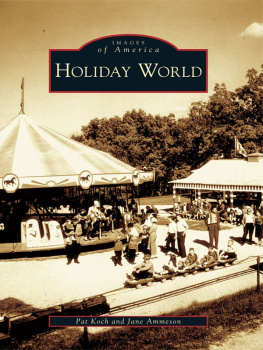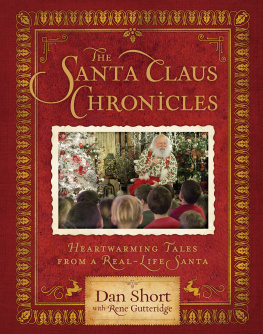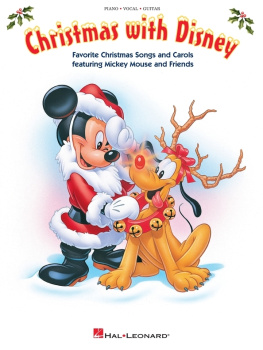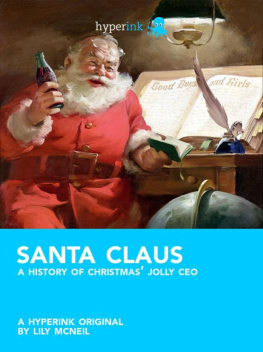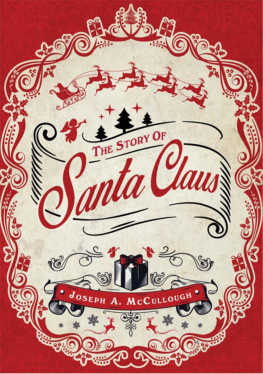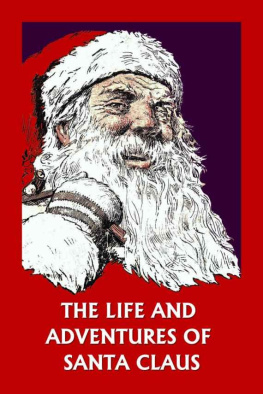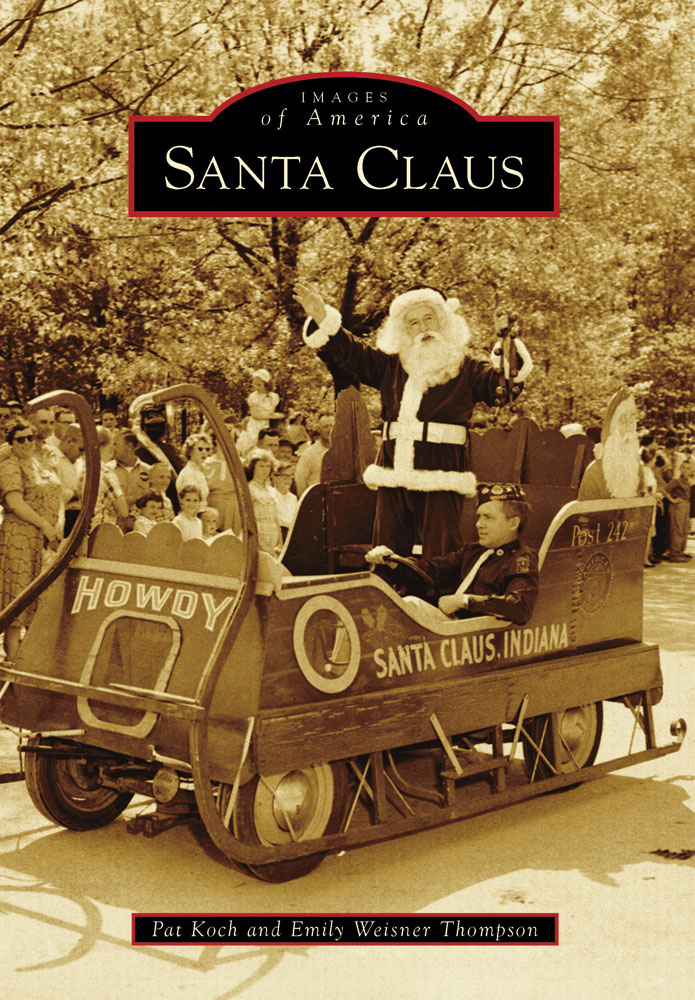
IMAGES
of America
SANTA CLAUS
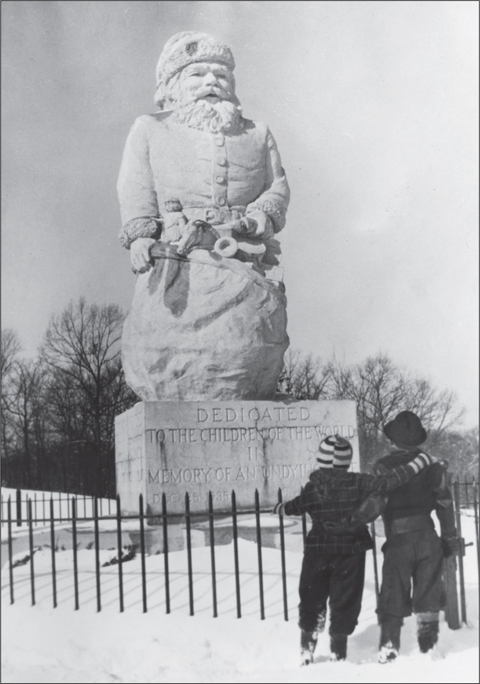
Patricia (left) and Raymond Yellig Jr. admire the 22-foot-tall Santa Claus Statue. The statue, commissioned by Carl Barrett, was built in 1935 and stood as the centerpiece of Santa Claus Park. Today, it is part of the Santa Claus Museum & Village. This photograph was taken in the early 1940s. (Courtesy of Holiday World and Splashin Safari.)
ON THE COVER: Santa Jim Yellig, who was Santa Claus for nearly 40 years, rides along with the American Legion during a holiday parade. These parades have always attracted a crowd, especially during the Christmas season, when residents gather to share in the holiday festivities. (Courtesy of the O.V. Brown Collection.)
IMAGES
of America
SANTA CLAUS
Pat Koch and Emily Weisner Thompson

Copyright 2013 by Pat Koch and Emily Thompson
ISBN 978-1-4675-1086-0
Ebook ISBN 9781439642504
Published by Arcadia Publishing
Charleston, South Carolina
Library of Congress Control Number: 2013937111
For all general information, please contact Arcadia Publishing:
Telephone 843-853-2070
Fax 843-853-0044
E-mail
For customer service and orders:
Toll-Free 1-888-313-2665
Visit us on the Internet at www.arcadiapublishing.com
To three great men: Raymond J. Santa Jim Yellig, who brought joy to innumerable children and adults; Louis J. Koch, who founded Santa Claus Land; and William A. Bill Koch, who brought their dreams to reality.
CONTENTS
I would like to thank all those who preserved their pictures and shared their memories with us. Because of you, this publication is possible. I am grateful to my five children for their constant love and support. I am deeply thankful to all who began and continue the great tradition of helping Santa answer childrens letters; they are truly Santas elves, who still give generously of their time each year to keep the spirit of Christmas alive and well. Thank you to our wonderful board of directors and our community partners. Finally, I am indebted to Emily Thompson, director of the Santa Claus Museum & Village, who worked tirelessly on this publication.
Pat Koch
The town of Santa Claus is a truly magical place, with a unique history unlike any other town in America. I am grateful to be part of this Christmas story. I would like to thank Pat Koch for pursuing her dream to preserve the history of this town and for her continuous support of the Santa Claus Museum & Village. Thanks go to the board of directors for serving as tireless advocates and volunteers for the museum. Special thanks also go to board member Nick Held and museum member Denise Martin, both of whom provided so many wonderful family stories and images. I am grateful to Paula Werne, Nathan Ryder, and Amanda Ellsworth for their assistance and support throughout this process. Thank you to Daryl Lovell, Jerry Sanders, and Kendell Thompson for taking the time to review the various drafts of this book. Thank you to Holiday World and Splashin Safari, Santas Candy Castle, the town of Santa Claus, Christmas Lake Village, the Spencer County Visitors Bureau, and all those organizations and individuals who provided stories and photographs. A very special thank you is also in order for my own personal Santa Claus, Bette Rice, and her family for welcoming me to such a wonderful town. Many thanks also go to Arcadia for publishing our story.
Emily Weisner Thompson
The images in this volume appear courtesy of Christmas Lake Village (CLV), Holiday World and Splashin Safari (HWSS), the O.V. Brown Collection (OV), the Spencer County Visitors Bureau (SCVB), and as otherwise noted in the captions.
Santa Claus, Indiana, is a tiny town with a big storya Christmas story. Visitors are curious and often ask questions that hit at the heart of the tale: How did this town get its name? How did the community begin? Why did people choose to live here? How did a celebrated theme park come to be located in this rural community? They should probably also ask, How did residents of a town of 30 people find themselves standing in the Oval Office in 1962? The answers to these questions are critical to understanding how a small farming settlement of German immigrants grew to attract national attention and visitors from all over the world.
Longtime Santa Claus resident Pat Koch grew up in the nearby town of Mariah Hill and has heard these questions countless times. One of Pats clearest memories from childhood is her grandmother Appalonia Schue referring to the town by its original name of Santa Fee rather than the more commonly accepted Santa Fe. Though it seemed Schue was using an incorrect term, her memory was crystal clear. Santa Fee, as it was called long before it became Santa Claus, was indeed the correct pronunciation.
Santa Fee, Indiana, was settled by farmers who were attracted to the rural beauty and fertile soil of the area. It was a wild country, and they would need to work hard to hack a living from the dense oak and hickory forests. Abraham Lincoln and his family moved to southern Indiana in 1816 and farmed their nearby land for over 14 years. The Lincolns lived just down the road from Santa Fee, and years later Abraham would reminisce about his boyhood experiences in his poem, The Bear Hunt. In it, he writes, When first my father settled here / Twas then the frontier line / The panthers scream, filled night with fear / And bears preyed on the swine. While southern Indiana in the early 1800s was a veritable wilderness, families made their homes and sunk their roots deep in the ground.
Although a tiny hamlet for over 100 years, Santa Fee was not destined for anonymity. In the mid-1800s, the town was forced to choose a new name in order to secure a post office. It seemed the towns name was too similar to that of another town in Indiana called Santa Fe, located a few hours north. The townspeople eventually settled on the name Santa Claus, though it is doubtful those early settlers could have anticipated the impact their choice would have on history. This decision, the story of which lives on in various myths and legends, propelled the town onto a national stage. Childrens letters to Santa Claus flooded the post office, and businessmen became interested in establishing tourist attractions centered on the Christmas theme. The town also caught the eye of Louis J. Koch, an entrepreneur from Evansville, who opened his little theme park, Santa Claus Land, in 1946.
Santa Claus Land eventually matured into Holiday World and Splashin Safari. The small town grew in response to the growth of the park, developing amenities and infrastructure to meet the needs of millions of visitors. New houses and communities popped up to provide homes for the increasing number of residents. Like many descendants of early Santa Claus families, Brian and Kelly Greulich connect personally to the park, as four generations of their family have worked on the grounds. Brians grandmother Agnes Collignon worked in the kitchen, his mother, Irene, was a waitress in the dining room, and Brian worked in the maintenance division. Now, their two children, Nikolaus and Heidi, spend their summers working at the park. Kelly works for the town of Santa Claus, and their family history remains intricately intertwined with the park and the town.
Many descendants of those original German pioneers still reside in the area, and they know their ancestors would not recognize the town today. Santa Claus, Indiana, has become an epicenter for the celebration of Christmas. It has shifted its core location, and there is very little remaining of the original town of Santa Fee; however, Santa Claus has not forgotten its roots. Strike up a conversation with anyone at the local post office or grocery store, and you will quickly learn that most folks can trace their family in this area back many generations. Family trees are often mapped in detail and intersect with dozens of other families in and around the town. Some people, such as Santa Claus native Greg Martin, can trace their history to several famous Santa Claus residents. The Martin family photographs capture priceless moments in time that otherwise may have been lost to history. This story is not unusual. When the idea for this book was planted, residents of Santa Claus and the surrounding area eagerly volunteered hundreds of photographs, allowing us to harvest a rich crop of images and stories. They are proud of their heritage and happy to share their memories.
Next page

